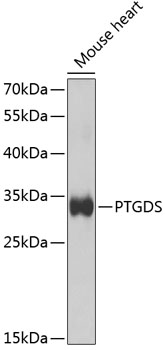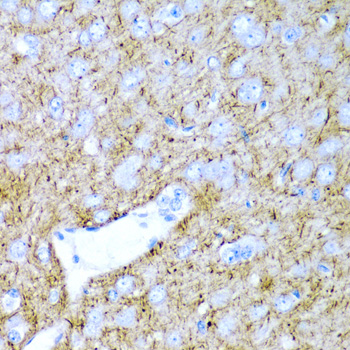Metabolism Antibodies 2
Anti-PTGDS Antibody (CAB1889)
- SKU:
- CAB1889
- Product Type:
- Antibody
- Reactivity:
- Human
- Reactivity:
- Mouse
- Reactivity:
- Rat
- Host Species:
- Rabbit
- Isotype:
- IgG
- Research Area:
- Metabolism
Description
| Antibody Name: | Anti-PTGDS Antibody |
| Antibody SKU: | CAB1889 |
| Antibody Size: | 20uL, 50uL, 100uL |
| Application: | WB IHC IF |
| Reactivity: | Human, Mouse, Rat |
| Host Species: | Rabbit |
| Immunogen: | Recombinant fusion protein containing a sequence corresponding to amino acids 23-190 of human PTGDS (NP_000945.3). |
| Application: | WB IHC IF |
| Recommended Dilution: | WB 1:500 - 1:2000 IHC 1:50 - 1:100 IF 1:50 - 1:100 |
| Reactivity: | Human, Mouse, Rat |
| Positive Samples: | Mouse heart |
| Immunogen: | Recombinant fusion protein containing a sequence corresponding to amino acids 23-190 of human PTGDS (NP_000945.3). |
| Purification Method: | Affinity purification |
| Storage Buffer: | Store at -20'C. Avoid freeze / thaw cycles. Buffer: PBS with 0.02% sodium azide, 50% glycerol, pH7.3. |
| Isotype: | IgG |
| Sequence: | APEA QVSV QPNF QQDK FLGR WFSA GLAS NSSW LREK KAAL SMCK SVVA PATD GGLN LTST FLRK NQCE TRTM LLQP AGSL GSYS YRSP HWGS TYSV SVVE TDYD QYAL LYSQ GSKG PGED FRMA TLYS RTQT PRAE LKEK FTAF CKAQ GFTE DTIV FLPQ TDKC MTEQ |
| Gene ID: | 5730 |
| Uniprot: | P41222 |
| Cellular Location: | Cytoplasm, Golgi apparatus, Nucleus membrane, Rough endoplasmic reticulum, Secreted, perinuclear region |
| Calculated MW: | 21kDa |
| Observed MW: | 33kDa |
| Synonyms: | PTGDS, L-PGDS, LPGDS, PDS, PGD2, PGDS, PGDS2 |
| Background: | The protein encoded by this gene is a glutathione-independent prostaglandin D synthase that catalyzes the conversion of prostaglandin H2 (PGH2) to postaglandin D2 (PGD2). PGD2 functions as a neuromodulator as well as a trophic factor in the central nervous system. PGD2 is also involved in smooth muscle contraction/relaxation and is a potent inhibitor of platelet aggregation. This gene is preferentially expressed in brain. Studies with transgenic mice overexpressing this gene suggest that this gene may be also involved in the regulation of non-rapid eye movement sleep. |
| UniProt Protein Function: | PTGDS: Catalyzes the conversion of PGH2 to PGD2, a prostaglandin involved in smooth muscle contraction/relaxation and a potent inhibitor of platelet aggregation. Involved in a variety of CNS functions, such as sedation, NREM sleep and PGE2-induced allodynia, and may have an anti-apoptotic role in oligodendrocytes. Binds small non-substrate lipophilic molecules, including biliverdin, bilirubin, retinal, retinoic acid and thyroid hormone, and may act as a scavenger for harmful hydrophopic molecules and as a secretory retinoid and thyroid hormone transporter. Possibly involved in development and maintenance of the blood-brain, blood-retina, blood-aqueous humor and blood-testis barrier. It is likely to play important roles in both maturation and maintenance of the central nervous system and male reproductive system. Belongs to the calycin superfamily. Lipocalin family. |
| UniProt Protein Details: | Protein type:EC 5.3.99.2; Secreted; Endoplasmic reticulum; Lipid Metabolism - arachidonic acid; Secreted, signal peptide; Isomerase Chromosomal Location of Human Ortholog: 9q34.2-q34.3 Cellular Component: Golgi apparatus; extracellular space; endoplasmic reticulum membrane; nuclear membrane; rough endoplasmic reticulum; perinuclear region of cytoplasm; extracellular region Molecular Function:retinoid binding; prostaglandin-D synthase activity; transporter activity; fatty acid binding Biological Process: transport; cyclooxygenase pathway; response to glucocorticoid stimulus; arachidonic acid metabolic process; prostaglandin biosynthetic process; regulation of circadian sleep/wake cycle, sleep |
| NCBI Summary: | The protein encoded by this gene is a glutathione-independent prostaglandin D synthase that catalyzes the conversion of prostaglandin H2 (PGH2) to postaglandin D2 (PGD2). PGD2 functions as a neuromodulator as well as a trophic factor in the central nervous system. PGD2 is also involved in smooth muscle contraction/relaxation and is a potent inhibitor of platelet aggregation. This gene is preferentially expressed in brain. Studies with transgenic mice overexpressing this gene suggest that this gene may be also involved in the regulation of non-rapid eye movement sleep. [provided by RefSeq, Jul 2008] |
| UniProt Code: | P41222 |
| NCBI GenInfo Identifier: | 730305 |
| NCBI Gene ID: | 5730 |
| NCBI Accession: | P41222.1 |
| UniProt Secondary Accession: | P41222,Q5SQ10, Q7M4P3, Q9UC22, Q9UCC9, Q9UCD9, B2R727 |
| UniProt Related Accession: | P41222 |
| Molecular Weight: | 21kDa |
| NCBI Full Name: | Prostaglandin-H2 D-isomerase |
| NCBI Synonym Full Names: | prostaglandin D2 synthase 21kDa (brain) |
| NCBI Official Symbol: | PTGDS |
| NCBI Official Synonym Symbols: | PDS; PGD2; PGDS; LPGDS; PGDS2; L-PGDS |
| NCBI Protein Information: | prostaglandin-H2 D-isomerase; cerebrin-28; PGD2 synthase; beta-trace protein; prostaglandin D synthase; prostaglandin-D2 synthase; glutathione-independent PGD synthase; glutathione-independent PGD synthetase; lipocalin-type prostaglandin D synthase; lipocalin-type prostaglandin-D synthase |
| UniProt Protein Name: | Prostaglandin-H2 D-isomerase |
| UniProt Synonym Protein Names: | Beta-trace protein; Cerebrin-28; Glutathione-independent PGD synthase; Lipocalin-type prostaglandin-D synthase; Prostaglandin-D2 synthase; PGD2 synthase; PGDS; PGDS2 |
| Protein Family: | Prostaglandin-H2 D-isomerase |
| UniProt Gene Name: | PTGDS |
| UniProt Entry Name: | PTGDS_HUMAN |
View AllClose








